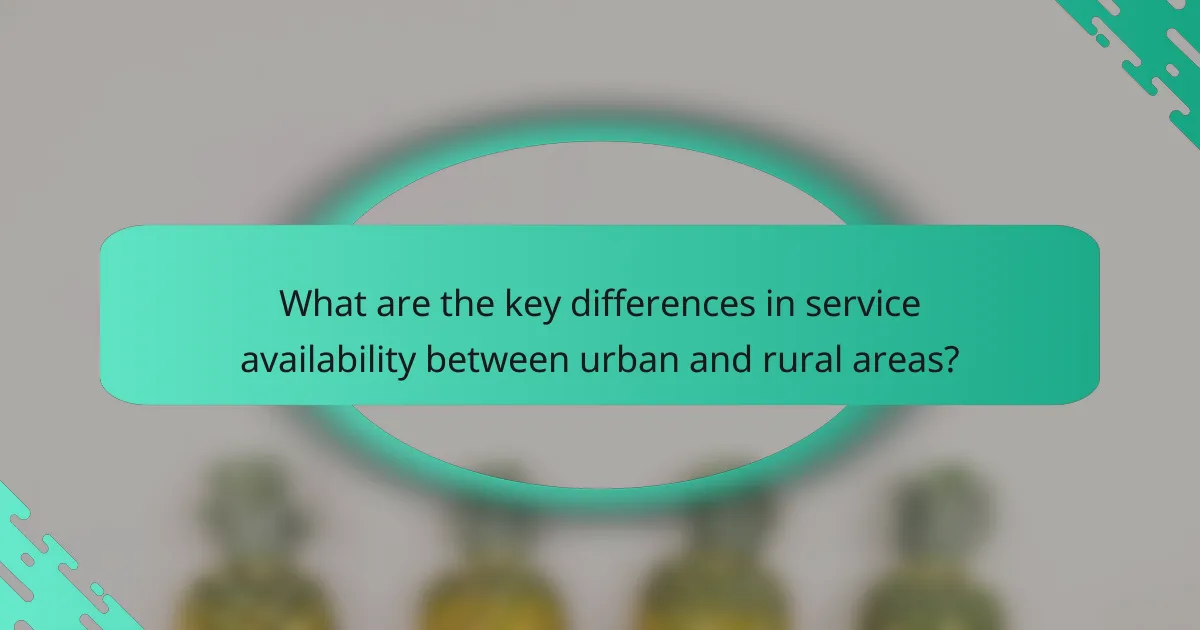The availability of services in urban and rural areas presents significant differences that impact residents’ daily lives. Urban regions generally offer a broader range of services with greater accessibility, while rural areas often struggle with limited options and longer response times. Factors such as population density, infrastructure, and resource allocation play crucial roles in shaping these disparities.

What are the key differences in service availability between urban and rural areas?
The key differences in service availability between urban and rural areas primarily revolve around the density and variety of services offered. Urban areas typically provide a wider range of services with greater accessibility, while rural regions often face limitations in both quantity and diversity of services available to residents.
Higher service density in urban areas
Urban areas boast a higher density of services, including healthcare, education, and public transportation. For instance, a city may have multiple hospitals, schools, and public transit options within a short distance, allowing residents easy access to essential services. This concentration often leads to shorter wait times and more competitive pricing for services.
Additionally, urban environments frequently host specialized services, such as niche healthcare providers or diverse cultural institutions, enhancing the overall quality of life. Residents can benefit from a variety of choices, enabling them to select services that best meet their needs.
Limited service options in rural areas
In contrast, rural areas often experience limited service options, which can significantly impact residents’ daily lives. Many rural communities may have only one healthcare facility or school, which can lead to longer travel times for essential services. For example, a resident might need to drive over an hour to reach a specialist or a larger hospital.
The scarcity of services can also result in higher costs due to the lack of competition. Residents may find themselves paying more for basic necessities, such as groceries or utilities, compared to their urban counterparts.
Impact of population density on service provision
Population density plays a crucial role in determining service provision. Urban areas, with their higher population densities, can support a greater variety of services due to the larger customer base. This allows service providers to operate more efficiently and economically, often leading to lower prices for consumers.
Conversely, rural areas typically have lower population densities, making it less feasible for businesses to offer a wide range of services. This can create a cycle where limited demand leads to fewer services, further discouraging new providers from entering the market. As a result, residents in rural areas may need to adapt by traveling longer distances or relying on fewer options for their needs.

How do service response times vary in urban versus rural settings?
Service response times differ significantly between urban and rural settings, primarily due to population density, resource allocation, and infrastructure. Urban areas typically experience quicker response times, while rural regions often face delays due to distance and fewer available services.
Faster response times in urban services
Urban services benefit from a higher concentration of resources and personnel, leading to faster response times. Emergency services, public transportation, and utility repairs can often respond within minutes due to their proximity and availability. For instance, emergency medical services in cities may arrive in under 10 minutes, while public transport options are frequent and easily accessible.
Additionally, urban areas often have advanced technology and infrastructure that streamline service delivery. For example, traffic management systems can optimize routes for emergency vehicles, further reducing response times. This efficiency is crucial in high-demand situations where every second counts.
Longer wait times for rural services
In contrast, rural services typically experience longer wait times due to greater distances and lower population density. Emergency services may take significantly longer to reach rural locations, often exceeding 20 minutes or more, depending on the remoteness of the area. This delay can be critical in emergencies where timely intervention is essential.
Moreover, rural areas often have limited service options, which can exacerbate wait times. For instance, fewer public transport routes and less frequent service can leave residents with limited choices, leading to longer travel times for essential services. Residents in these areas should plan ahead and consider alternatives, such as carpooling or local community resources, to mitigate these delays.

What factors influence service availability in urban areas?
Service availability in urban areas is primarily influenced by infrastructure, transportation access, and competition among service providers. These factors create a dynamic environment where services can be more readily accessible compared to rural settings.
Infrastructure and transportation access
Urban areas typically benefit from advanced infrastructure, including roads, public transit, and utilities, which enhance service availability. Well-maintained roads and efficient public transport systems enable quicker access to services, reducing wait times and improving overall convenience.
For example, cities often have multiple public transportation options, such as buses and subways, allowing residents to reach service providers within short travel times, often under 30 minutes. In contrast, rural areas may lack such infrastructure, leading to longer travel distances and times for essential services.
Higher competition among service providers
The concentration of population in urban areas fosters higher competition among service providers, which can lead to improved service quality and lower prices. With numerous businesses vying for customers, residents often have a variety of options for services like healthcare, dining, and entertainment.
This competitive landscape can result in better service offerings, as providers strive to differentiate themselves. For instance, urban residents might find several healthcare clinics within a few blocks, each offering various specialties and pricing structures, unlike rural areas where options may be limited to a single provider.

What factors influence service availability in rural areas?
Service availability in rural areas is primarily influenced by geographic isolation, lower population density, and limited resources. These factors create unique challenges that affect the accessibility and quality of services such as healthcare, education, and public utilities.
Geographic isolation and lower demand
Geographic isolation in rural areas often leads to lower demand for services, as fewer people live in these regions. This reduced demand can discourage businesses and service providers from establishing operations, resulting in limited options for residents.
For instance, a small town may have only one grocery store, which can impact pricing and product variety. Residents may need to travel significant distances to access specialized services, such as hospitals or educational institutions, which can be inconvenient and costly.
Limited workforce and resources
Rural areas frequently face challenges related to a limited workforce and scarce resources. With fewer professionals available, services such as healthcare and education may be understaffed, leading to longer wait times and reduced quality of care.
Additionally, funding for public services in rural regions is often lower than in urban areas, which can hinder infrastructure development and maintenance. Local governments may struggle to provide essential services, such as reliable internet access or public transportation, further exacerbating the challenges faced by rural residents.

How do pricing structures differ between urban and rural services?
Pricing structures for services vary significantly between urban and rural areas, primarily due to differences in demand, operational costs, and competition. Urban services often face higher prices due to increased demand and overhead costs, while rural services typically have lower prices but may also have limited availability and options.
Higher prices in urban markets
Urban markets generally experience higher prices for services due to factors such as higher rent, labor costs, and a greater concentration of customers. For example, a haircut in a city may cost between $30 to $70, while the same service in a rural area might be priced significantly lower.
Additionally, urban areas often have more competition, which can drive prices up as businesses strive to offer premium services. This can lead to a wider range of service options, but customers may pay a premium for convenience and accessibility.
Lower costs in rural services
Rural services tend to have lower costs, reflecting lower overhead expenses and less competition. For instance, a typical monthly internet plan in a rural area might range from $40 to $60, compared to urban plans that can exceed $100 for similar speeds.
However, while prices are generally lower, rural services may come with trade-offs such as limited availability, slower response times, and fewer service options. Consumers should weigh these factors when choosing between urban and rural services to ensure they meet their needs effectively.

What are the implications of service availability for residents?
The availability of services significantly impacts residents’ quality of life, influencing access to healthcare, education, and employment opportunities. Urban areas typically offer a wider range of services, while rural communities often face limitations that can affect daily living and long-term development.
Access to essential services in urban areas
Urban areas generally provide residents with better access to essential services such as healthcare, education, and public transportation. For instance, cities often have multiple hospitals, clinics, and specialized medical facilities within a short distance, making it easier for residents to receive timely care.
Additionally, urban centers tend to have a variety of educational institutions, from primary schools to universities, which cater to diverse learning needs. Public transportation options, including buses and trains, are usually more frequent and reliable, allowing residents to commute efficiently.
Challenges in accessing services in rural communities
Rural communities frequently encounter significant challenges in accessing essential services due to their geographic isolation and lower population density. Healthcare facilities may be limited, with residents often needing to travel long distances to receive medical attention, which can lead to delays in treatment.
Education options can also be restricted, with fewer schools available and potential difficulties in attracting qualified teachers. Furthermore, public transportation may be sparse, making it harder for residents to reach jobs or services, which can hinder economic opportunities and social mobility.

What are the emerging trends in urban and rural service provision?
Emerging trends in urban and rural service provision highlight significant differences in accessibility, technology integration, and community engagement. Urban areas often benefit from advanced infrastructure and diverse services, while rural regions face challenges in service availability and delivery methods.
Technology Integration in Urban Services
Urban services increasingly leverage technology to enhance efficiency and accessibility. Smart city initiatives utilize data analytics and IoT devices to optimize public transport, waste management, and energy consumption. For instance, cities may implement real-time tracking for buses, improving commuter experience.
However, the rapid adoption of technology can create disparities, as not all residents may have equal access to digital tools. It’s essential for urban planners to ensure that technology benefits all community members, including those with limited digital literacy.
Challenges in Rural Service Provision
Rural areas often encounter significant obstacles in service provision, including limited infrastructure and lower population density. These factors can lead to fewer healthcare facilities, educational institutions, and public transport options. For example, a rural community might have only one clinic serving a large geographic area, making access to healthcare challenging.
To address these challenges, rural service providers may explore mobile services or telehealth options, which can bridge gaps in access. Collaboration between local governments and private entities can also enhance service delivery in these regions.
Community Engagement and Participation
Community engagement plays a crucial role in both urban and rural service provision. In urban settings, local governments often involve residents in decision-making processes through public forums and surveys. This engagement helps tailor services to meet the diverse needs of the population.
In rural areas, fostering community participation can be even more vital due to the close-knit nature of these populations. Initiatives that encourage local input can lead to more effective service delivery and stronger community ties, ensuring that services reflect the unique needs of rural residents.


